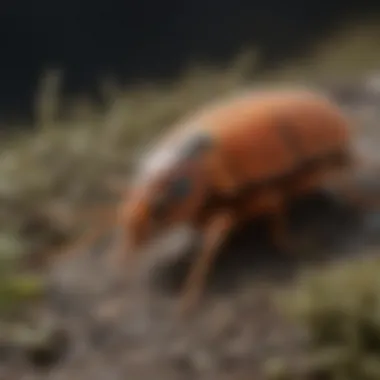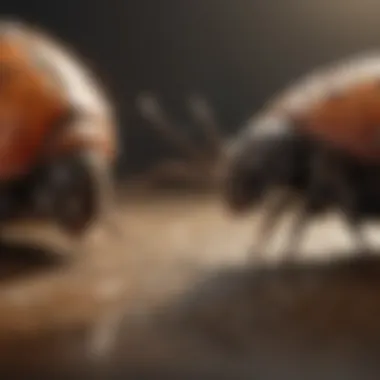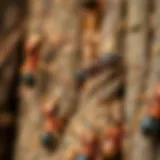Effective Pest Control Strategies in Putnam, CT


Intro
Pest control is an issue that can't be brushed under the rug, especially in Putnam, CT. The diverse environment and climate create ideal conditions for various pests to thrive. While some folks may think that dealing with pests is solely a matter of spraying some chemicals and calling it a day, the experience is often far more nuanced. Understanding the local pest population, knowing how to spot the early signs of an infestation, and taking preventive measures can keep your home safe and comfortable.
This article will guide homeowners through a detailed landscape of pest management strategies. We’ll not only pinpoint the common culprits but also demystify prevention and treatment options that align with community needs.
Pest Identification
Identifying pests accurately is the first step in leveraging effective control strategies. Knowing what’s lurking around your property can be a game changer. In Putnam, the critters may include:
- Ants: Carpenter ants may cause structural damage. Look for sawdust piles and listen for rustling sounds in wood.
- Termites: Subterranean termites thrive on cellulose material. Watch for mud tubes along foundation walls, and swarmer termites during spring.
- Rodents: The telltale signs include chew marks, droppings, and nesting materials. Mice can fit through a hole the size of a dime!
- Cockroaches: Dark brown to black, these pests often leave behind a musty smell and egg cases.
Signs and Symptoms of Infestations
Beyond recognizing pests, you also need to keep an eye out for their signs. This can include:
- Small, irregular holes in walls or wood.
- Unusual noises in the attic or behind walls, such as scratching or squeaking.
- Unexplained stains on ceilings or walls, which may indicate leaks from rodent-infested areas.
- Allergic reactions to pest droppings or shedding, especially in the case of cockroaches.
"Early detection often makes the difference between minor annoyances and major problems."
Prevention Strategies
Now that we’ve covered identification, let’s switch gears and chat a bit about prevention.
Home Maintenance Tips for Pest Prevention
Proper upkeep of your home can minimize chances of infestation:
- Seal Entry Points: Check windows, door frames, and foundations for cracks or gaps, and seal them up.
- Keep Tidy: Regularly clean your home, especially in hard-to-reach areas where crumbs and dirt can accumulate.
- Food Storage: Store food in airtight containers to keep pests at bay.
- Reduce Moisture: Fix leaky pipes and use dehumidifiers in damp areas such as basements.
Natural Deterrents and Barriers
Sometimes, a little creativity can go a long way. Consider:
- Essential Oils: Certain oils like peppermint or tea tree can repel pests.
- Vinegar: Spraying a vinegar solution can keep ants and cockroaches at bay.
- Diatomaceous Earth: Sprinkling this around can help control crawling insects.
Treatment Options
When prevention isn't enough, it’s time to think about treatment.
Overview of Chemical vs. Natural Treatments
While chemical treatments can be effective, they often come with a host of concerns surrounding safety and environmental impacts. On the other hand, natural methods often require more frequent application but can be less hazardous to your family's health.
Step-by-step Guides for DIY Treatments
Want to try your hand at tackling infestations yourself? Here's a quick guide:
- Identify the pest: Make sure you know exactly what you’re dealing with.
- Choose a treatment method: Decide if you prefer chemical or natural approaches.
- Gather supplies: Make sure you have the necessary tools and materials ready.
- Apply your treatment: Follow the directions closely, whether it’s using a spray, trap, or natural deterrent.
- Monitor the situation: Keep an eye out for any signs of re-infestation.
Understanding these elements empowers homeowners in Putnam to face pest challenges head-on. Ultimately, an informed approach can safeguard both property and peace of mind.
Prelude to Pest Control
Pest control isn't just about swatting a fly here or stepping on a rogue ant there. In the quiet charm of Putnam, CT, the importance of pest control weighs heavily on both homeowners and property managers. The variety of pests that infiltrate homes can lead to significant structural damage or even health concerns. This section serves as the gateway to understanding the complexities of pest control, highlighting its essentials.
Understanding the Importance of Pest Control
In today's world, the role of pest control has evolved far beyond mere aesthetics. The presence of pests can disrupt a household's peace, causing distress and uncertainty. Many people might dismiss pests as mere nuisances, but these unwelcome visitors can be voracious eaters, eroding the foundations of a home and costing owners substantial repair bills in the long run.
Moreover, pest control is crucial for maintaining a healthy living environment. Pests like rodents and insects often carry diseases that can directly jeopardize the health of your family. For instance, did you know that rodents can transmit leptospirosis and hantavirus? Such illnesses can lead to serious health risks. Focusing on pest control means safeguarding your home against potential threats.
In Putnam, where nature’s bounty can sometimes be a double-edged sword, effective pest control ensures that the balance between human habitation and wildlife remains undisturbed. It invites a sense of security, allowing homeowners to rest easy.
Economic and Health Implications of Pests


The economic toll inflicted by pest infestations can be staggering. It’s not just the cost of calling an exterminator or purchasing traps. Think of the potential expenses linked to damaged property: chewed wiring, ruined insulation, and structural issues all add up. In a place like Putnam, where many homeowners value their investments, neglecting pest management can lead to spiraling costs.
Beyond the monetary aspects, the health implications cannot be overlooked. Many pests pose diverse health risks. Consider the itchy discomfort of bed bug bites or the rising instances of Lyme disease linked to ticks. Take action sooner rather than later—proactive measures can save both your health and wallet.
"A penny saved is a penny earned, but a penny spent on pest control can save countless dollars on repairs and health issues."
Getting ahead of potential pest issues not only enhances the quality of your living space but also protects your most valuable asset—your home. Vigilance in pest control leads to lasting peace of mind.
In summary, pest control is a vital concern that reverberates through financial stability and health. The following sections will dive deeper into practical strategies for pest identification, prevention, and effective treatment, all aimed at fostering a pest-free environment in Putnam.
Common Pests in Putnam, CT
Understanding the various pests prevalent in Putnam, CT, is crucial for creating a robust pest management strategy. These pests, some notorious for their destructive tendencies, can lead to significant economic strain on homeowners if not addressed promptly. For instance, termites can quietly munch away at the core structure of a home, often unnoticed until the damage becomes apparent. Likewise, rodents, like mice and rats, can pose health risks while also wreaking havoc on insulation and wiring. Knowing what pests commonly invade local properties provides a foundation for effective identification, prevention, and treatment options. As we explore the intricacies of local pest issues, it becomes clear that each pest brings its own set of challenges and implications for homeowners.
Identifying Common Termite Species
In Putnam, homeowners need to be aware of the prevalent termite species. The eastern subterranean termite is notably common and often infests structures from below the ground level. These little critters favor damp, deteriorating wood as their main food source, which can lead to substantial damage over time. Another species, the drywood termite, although less common here, can still be found. Unlike their subterranean cousins, they do not need contact with soil, which allows them to infest furniture or wooden panels in homes quite effortlessly.
To identify a termite infestation, look for signs such as mud tubes on foundation walls, discarded wings near windows or doors, and the sound of chewing within hollowed wood. Understanding the specific characteristics of these termites can help homeowners distinguish them from other wood-boring pests.
Understanding Other Common Infestations
Beyond termites, there are several other pests that frequently cause headaches for Putnam residents. Ants are particularly bothersome, especially species like Carpenter ants, which can damage wood structures, albeit less aggressively than termites.
Additionally, homeowners often report issues with bedbugs, notorious for their elusive nature and discomfort they cause during the night. These pests hitch rides on luggage and clothing, making them more challenging to eradicate.
Another common nuisance is the cockroach. They are not only unsightly but also pose a health risk due to the allergens they produce. Recognizing early signs of infestations—like droppings or egg cases—can prevent a minor annoyance from becoming a serious problem.
Seasonal Pest Trends in Putnam
Understanding the seasonal patterns of pest activity in Putnam is invaluable for effective pest management. For example, as the weather warms in spring, many insects become active. Ants emerge from their colonies, seeking food, while termites begin their swarm, looking for new sites to infest.
Summer is often the height of pest activity. Homeowners might see an uptick in mosquito populations due to warmer temperatures and increased standing water from rain.
As the seasons transition into fall, rodents often seek shelter indoors to escape the cooling temperatures. It's during this time that preventative measures, like sealing entry points, become essential.
In winter, while many pests are dormant, it's still crucial to remain vigilant, as some, like mice, will look for warmth in homes. Knowing these trends allows proactive measures to minimize infestations, saving time and expense.
"Pest control is not about fighting an eternal battle; it’s more about outsmarting your foes before they settle in."
By familiarizing ourselves with these common pests and their behaviors, Putnam residents can better prepare for and prevent infestations, creating a safer and more comfortable living environment.
Pest Identification Techniques
Identifying pests is the first step in effective pest control. Understanding what you're dealing with allows for proper treatment and prevention methods to be applied. Knowledge of the pest's habits, environment, and lifecycle can greatly improve your success rate. Here, we will delve deeper into various pest identification techniques that homeowners in Putnam can employ, ensuring their living spaces remain safe and pest-free.
Visual Inspection Methods
Visual inspection is often the simplest and most immediate way to start identifying a pest problem. Searching for signs of infestation involves looking closely at different areas of your home. Key elements to check include:
- Entry points: Windows, doors, and foundation cracks can serve as welcoming mats for pests.
- Common hiding spots: Pest control experts stress the importance of inspecting corners, under sinks, inside cabinets, and behind appliances such as fridges and stoves.
- Physical signs: Look for droppings, shed skins, or nesting materials. For instance, rodent droppings are often small, black, and pellet-shaped, while cockroach droppings resemble coffee grounds.
Visual inspection allows for quick action; however, it requires keen observation skills and knowledge about the specific signs associated with different pests.
Utilizing Traps and Baits
Using traps and baits provides another effective layer of pest identification. This method not only captures pests but can also help pinpoint potential infestations. Here’s how to go about it:
- Different traps for different pests: Glue boards can help capture insects, while snap traps or electric traps are often preferred for rodents.
- Placement matters: Setting traps in areas where you see signs of pest activity can yield better results. Common locations include along walls and near food sources.
- Monitoring results: Regularly checking traps not only helps confirm the presence of pests but also allows for timely response to control numbers before they surge.
Keep in mind that while traps are an excellent detection tool, they will not eliminate larger infestations.
When to Call a Professional
Even with thorough visual inspections and traps, some infestations can spiral out of control. Knowing when to call a professional can save homeowners time, money, and headaches. Here are some factors to consider:
A key sign to seek help is when pest populations become unmanageable or if DIY methods fail to yield results.


- Type of pest: Some insects and rodents can reproduce quickly. This creates an urgency if you notice anything more serious, like termites, which are notorious for causing structural damage.
- Health concerns: Pests like cockroaches and rodents can contribute to health issues. If you have children or pets, the urgency increases due to potential health risks.
- Ongoing infestations: If you find yourself dealing with recurring pest issues, it’s likely time to consult professionals who understand the local ecosystem, and pre-existing infestation hotspots.
By ensuring these techniques are part of your pest control strategy, you can effectively identify and manage the pest issues befalling your home in Putnam, CT.
Preventive Measures
Preventive measures are the backbone of effective pest control, particularly in a region like Putnam, CT, where diverse pests can pose significant challenges. Implementing preventive strategies not only helps in managing existing pest problems but actively works towards avoiding future infestations. This proactivity can save homeowners considerable time, effort, and resources down the line.
Maintaining a Pest-Free Home Environment
Creating a pest-free environment starts at home. Keeping your house tidy goes a long way. Regularly vacuuming, dusting, and disposing of trash minimizes the food sources that attract pests. Pay special attention to areas like kitchens and dining rooms where crumbs or spills are likely to accumulate. Sealing food in airtight containers can also greatly reduce the chances of attracting unwanted visitors.
You should also ensure that any leaks or moisture issues are addressed promptly. Pests like cockroaches and termites are drawn to damp environments; thus, repairing plumbing leaks and utilizing dehumidifiers in wetter areas of your home can help keep them at bay. Furthermore, consider installing door sweeps and window screens to keep pests from entering.
Landscaping Choices That Deter Pests
The outside of your property plays a crucial role in pest management. Thoughtful landscaping choices can act as your first line of defense. For instance, rather than planting dense shrubs close to your house, provide a buffer zone of rocks or gravel to reduce pest hiding spots.
Also, be selective in your choice of plants. Certain species like marigolds and lavender are known for their natural pest-repelling qualities. Maintaining a well-trimmed yard deprives pests of potential nesting grounds. Consider removing debris such as leaves and logs where pests could take up residence.
Regular Maintenance and Inspections
Constant vigilance can lead to early detection of pest issues. Schedule regular inspections of your property, ideally twice a year. Keep an eye out for signs of infestations such as droppings, gnaw markings or damaged vegetation. It may also be wise to informally inspect the nooks and crannies where pests might lurk - think basements, attics or behind appliances.
In addition to visual inspections, employing pest control professionals for routine checks can uncover problems before they escalate. These experts are trained to spot early indicators that you might overlook. Moreover, engaging in regular maintenance tasks, like cleaning gutters and ensuring proper drainage, will create an inhospitable environment for pests.
"Prevention is Better than Cure" – this saying holds especially true when it comes to pest control strategies at home. Taking these preventive measures can save you from a headache later.
Effective Treatment Options
When dealing with pest problems, understanding the treatment options available is crucial for effective resolution. The success of pest control hinges on selecting the right approach that addresses the specific type of infestation while considering safety, environmental impact, and long-term effectiveness. This section discusses various treatment methods, including natural remedies, chemical applications, and integrated pest management strategies. Each method offers unique benefits and must be evaluated based on the context of the pest issue and the preferences of the homeowner.
Natural Remedies for Pest Control
Natural remedies have gained popularity among homeowners looking for safer, eco-friendly options to manage pests. Often, they can be just as effective as traditional treatments, without the health concerns associated with harsher chemicals.
Some effective natural solutions include:
- Essential Oils: Oils like peppermint, tea tree, and eucalyptus repel various pests, such as spiders and mosquitoes. Simply mix a few drops with water in a spray bottle and apply where necessary.
- Diatomaceous Earth: A chalky substance composed of fossilized algae, diatomaceous earth is effective against crawling insects. It works by dehydrating pests that come into contact with it.
- Vinegar: A simple solution for fruit flies and other short-lived pests. A mix of vinegar and water in a spray bottle can deter these nuisances and leave a pleasant scent.
The use of natural remedies encourages sustainable practices. However, they may not display immediate effects and often require consistent application and patience, which can challenge some homeowners.
Chemical Treatments and Their Safety
Chemical treatments can be potent tools in combating larger infestations. Products vary in formulation, and their application often demands precision to minimize risks to humans and pets. When considering chemical pesticides, it's essential to understand their components and follow guidelines to ensure safety.
- Targeted Applications: Using pesticides only in infested areas can help limit exposure. This approach is often more effective than blanket treatments.
- Safety Measures: Homeowners should adhere to safety precautions, including wearing protective gear and ensuring proper ventilation during application.
- Label Instructions: Always read the product label thoroughly. It contains essential information on safe use, dosage, and precautions to consider.
While chemical treatments can serve as quick solutions, they are sometimes linked to health risks, making it vital for users to balance effectiveness and safety when selecting these products.
Integrated Pest Management Strategies
Integrated Pest Management (IPM) represents a holistic approach to pest control, combining multiple strategies to achieve effective results with minimal environmental impact. Here's how IPM works:
- Monitoring: Regular inspection of the property to identify potential pest problems. Keeping an eye on pest activity can help in taking proactive measures before an infestation escalates.
- Prevention: By altering environmental conditions and taking preventive measures, homeowners can significantly reduce the likelihood of infestations. This includes sealing entry points and minimizing food sources.
- Control Methods: Utilizing a mix of natural and chemical approaches tailored to the specific pest problem identified during monitoring. This ensures the most effective and safe treatment is applied.
- Evaluation: After implementing control methods, homeowners should evaluate their effectiveness. If necessary, adjustments can be made to enhance results and prevent future occurrences.
By employing IPM strategies, homeowners not only manage pests efficiently but also protect their health and the environment, fostering a sustainable living space.
"The essence of effective pest control lies not merely in eradication but in creating conditions that deter pest habitation in the first place."
Local Pest Control Services in Putnam
When it comes to pest management, understanding local pest control services is vital for homeowners in Putnam, CT. The local environment, with its particular climate and geography, plays a huge part in the type of pest issues that can arise. Local providers are often familiar with regional behaviors of pests, meaning they can offer targeted solutions that are not only effective but also considerate of the community’s specific needs.
Working with a local pest control service can yield many benefits:
- Tailored Solutions: These services often customize their methods to effectively treat local infestations.
- Rapid Response: Being in the same area allows them to respond promptly to urgent pest challenges.
- Community Connection: They are likely invested in the community, prioritizing sustainable practices that preserve the local ecosystem.


Ultimately, choosing a local pest control provider can mean a pest-free home and peace of mind, knowing your concerns are handled by professionals who understand local context.
Choosing the Right Pest Control Provider
Selecting the right pest control provider is no small task. It’s not like picking a random item off a store shelf. Considerations such as experience, expertise, and range of services should be high on your priority list. Here are several factors to weigh:
- Experience and Credentials: Look for companies with certified professionals and years in the field.
- Range of Services: Different pests require different tactics. A provider should be equipped to handle various pest challenges, from rodents to termites.
- Techniques Used: Some companies may focus solely on chemical solutions, while others adopt integrated pest management strategies. Decide what fits best with your values.
Checking for these elements can help ensure that you’re partnering with a reliable service that can adequately address your needs.
Comparing Services and Costs
Just like shopping for groceries, it's best to compare several local pest control options before making a decision. Costs can vary significantly between companies, and understanding what they offer for those prices is important.
- Get Multiple Quotes: Reach out to several pest control providers for detailed estimates.
- Understand the Trigger Points for the Price: Some services might charge more for initial setup or specialized treatments. Knowing this allows for better budgeting.
- Look Out for Hidden Fees: Be mindful of extras that might jack up the final bill, such as additional treatments or follow-up visits.
This due diligence ensures you aren’t left holding the bag—or the pests—after spending your hard-earned money.
Reading Reviews and Recommendations
In today’s digital world, reading online reviews has become almost second nature. But, it’s not just about star ratings; it’s about what those reviews say. Considering the voice of the community can guide your choice:
- Google Reviews and Social Media: Check platforms like Facebook and Reddit for firsthand accounts of other homeowners' experiences.
- Word of Mouth: Sometimes, the best advice comes from friends and neighbors. They might know reliable pest control options that work well in your area.
- Better Business Bureau: Look at the company’s rating on the BBB for insights into their reputation and customer complaint histories.
The key here is to gather a well-rounded view by using multiple sources. It’s better to take your time rather than rushing into a decision that could lead to more complications down the line.
By focusing on these elements—choosing the right provider, comparing various services and costs, and examining reviews—you can approach pest control in Putnam with clarity and confidence.
Debunking Pest Control Myths
Understanding pest control is not just about managing infestations; it’s also about navigating the many myths and misconceptions that can cloud judgment. In Putnam, CT, where various pests thrive in different seasons, it is vital to separate fact from fiction. Debunking these myths can lead to more effective pest management strategies, ultimately saving time, money, and frustration for homeowners.
Common Misconceptions About Pests
There are several misconceptions about pests that often circulate among homeowners. Some people believe that all pests are harmful, while others think that they are merely a nuisance. However, it’s essential to recognize that not all pests pose a direct threat. For instance, ladybugs and lacewings can actually benefit the ecosystem by controlling aphid populations, thus providing a natural pest control solution.
Another prevalent myth is that pests are attracted to dirty homes alone. While cleanliness plays a significant role in prevention, other factors like structural issues—cracks, leaks, and gaps—are also huge contributors to pest attraction. A clean home is no guarantee against an infestation if these underlying issues are not addressed.
Moreover, there is a belief that professional pest control services are only necessary after a significant infestation has emerged. The truth is that regular inspections can catch problems before they escalate, reducing the risk of expensive damage or health hazards.
Being mindful of these misconceptions can equip homeowners with the right mindset for tackling pest control more effectively.
Understanding Chemical Safety
When it comes to pest control, debates surrounding the safety of chemicals used often surface. Many homemakers worry about the impact these chemicals might have on their families and pets. It's essential to understand that not all chemical treatments are created equal. There are varying degrees of safety associated with different types of pesticides.
When using pesticides, always read labels carefully. Each product provides instructions regarding safe usage, ranging from application methods to necessary safety precautions. Many modern pesticides are designed to be less harmful to humans and pets, yet it’s critical to avoid complacency.
In addition to following instructions closely, consider using Integrated Pest Management (IPM) practices. This approach combines various strategies—biological, cultural, and chemical—to manage pests in the most sustainable way possible.
"Chemical safety in pest control isn’t just about reducing exposure; it's a full-circle approach that considers preventing infestations from starting in the first place."
Educating oneself about the chemicals being used can foster a better understanding and reduce anxiety around pest management solutions.
In summary, debunking myths about pests and understanding chemical safety contribute significantly to effective pest control. Being informed empowers homeowners to make smarter decisions, ensuring that their living environments remain safe and pest-free.
Epilogue and Moving Forward
In sum, navigating the intricate landscape of pest control in Putnam, CT, is essential for maintaining a healthy and pleasant living environment. The culmination of effective strategies—spanning identification, prevention, treatment, and engagement with local services—forms a sturdy foundation. This final section aims to encapsulate the critical aspects covered throughout the article while encouraging ongoing learning and adaptation.
Summary of Key Takeaways
- Pest Identification: Recognizing the signs of various pests permits timely intervention. Visual inspections, monitoring traps, and understanding seasonal trends are indispensable.
- Prevention is Key: Implementing preventive measures, like regular home maintenance and landscaping choices, proactively blocks potential infestations.
- Diverse Treatment Options: There's no one-size-fits-all solution; familiarity with natural remedies, chemical treatments, and integrated pest management strategies provides flexibility in approaches.
- Local Resources: Engaging with the right pest control services in Putnam can significantly ease the burden. Your choice should be informed by thorough comparisons and genuine customer feedback to ensure satisfactory outcomes.
- Combatting Myths: Dispelling misconceptions surrounding pests and their management helps foster a realistic approach to pest control, enhancing safety and effectiveness.
Encouragement for Ongoing Education
Awareness never sleeps. Staying informed about emerging pest challenges and innovative control methods can empower homeowners and property managers alike. Numerous resources are at your fingertips: books, local workshops, and online platforms offer continuous learning opportunities on pest management and prevention.
Take strides to engage with community forums or social media groups to share experiences and advice. Parents and homeowners alike can benefit from leveraging collective knowledge, building a tapestry of experiences and resources.
"The best defense is a good offense." This adage holds true in pest control; being proactive instead of reactive is a better pathway to reduce pest-related issues down the line.
By treating pest control as an ongoing journey rather than a one-time fix, you'll foster a more sustainable environment. This not only keeps your home bug-free but also contributes to overall community well-being through responsible practices. Always remember, the information doesn't just end here—it's a continuous cycle of learning and adapting.



